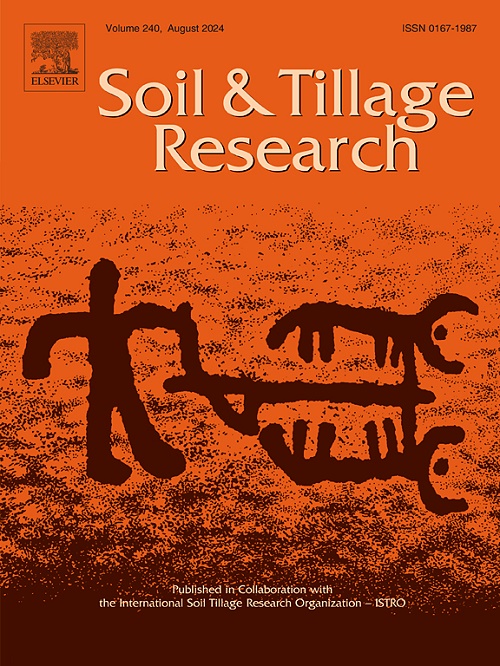富碳土壤改良剂的早期效应在维持氮素和产量水平的同时刺激了与保持有关的氮基因
IF 6.8
1区 农林科学
Q1 SOIL SCIENCE
引用次数: 0
摘要
了解土壤改良剂和低干扰措施对土壤健康、养分循环和微生物活性的影响对提高农业可持续性至关重要。Ramial chipped wood (RCW)是一种很有前途的富碳有机土壤改良剂,但其对微生物活性、氮循环基因和微生物分类群的影响,特别是跨土壤深度的影响,目前尚不清楚。本研究旨在评估免耕后第二年施用RCW对土壤各种特性的短期影响,包括微生物组成和氮循环基因。本试验以地中海地区的一种作物番茄(Solanum lycopersicum)为研究对象。我们比较了rcw处理土壤的表层(0-20 cm)和表层下(20-25 cm)宏基因组与标准富氮有机颗粒(CTL)和堆肥(CMP)处理土壤的宏基因组。RCW,特别是高剂量(RCW- hd),在早期阶段增加了土壤有机碳和微生物生物量。尽管减少了50% %的有机肥用量,但RCW-HD并未降低氮素有效性和作物生产力,这表明氮素利用效率有所提高。与RCW-HD相比,CTL下几个n循环基因丰度升高,包括与硝化相关的pmoA-amoA(+42 %)和pmoC-amoC(+72 %),以及与反硝化相关的nosZ(+14 %)。RCW-HD免耕系统增加了硝酸盐还原同化(+13 % nrtABC),有利于固氮细菌属,如Terrihabitans, Ferriphaselus, Azospira和Rhodopseudomonas。土壤深度显著影响了72 %的氮循环基因,关键基因在地表更为丰富。这些结果强调了RCW在改善N保持和土壤肥力,同时减少肥料依赖和温室气体排放方面的潜力。它们还通过强调微生物群如何促进氮循环效率,支持可再生农业的可持续实践。本文章由计算机程序翻译,如有差异,请以英文原文为准。
Early-stage effects of carbon-rich soil amendments stimulate retention-related nitrogen genes while maintaining nitrogen and yield levels
Understanding the effects of soil amendments and low disturbance practices on soil health, nutrient cycling and microbial activity is essential for improving agricultural sustainability. Ramial chipped wood (RCW) is a promising carbon-rich organic soil amendment but its effects on microbial activity, nitrogen (N) cycling genes and microbial taxa, particularly across soil depth, remain poorly understood. This study aimed to evaluate the short-term effects of RCW applications following a no-till practice on various soil properties including microbial composition and N cycling genes, during the second year after RCW incorporation. The experiment was conducted using tomato (Solanum lycopersicum) as a crop species in the Mediterranean region. We compared the surface (0–20 cm) and subsurface (20–25 cm) metagenomes of RCW-treated soils with those treated with standard N-rich organic pellet, as a control, (CTL) and compost (CMP). RCW, particularly at high doses (RCW-HD), increased soil organic carbon and microbial biomass at an early stage. Despite a 50 % reduction in organic fertiliser use, RCW-HD did not reduce N availability and crop productivity, suggesting improved N use efficiency. Several N-cycling gene abundances were elevated under CTL compared to RCW-HD, including the nitrification-related pmoA-amoA (+42 %) and pmoC-amoC (+72 %), and the denitrification-related nosZ (+14 %). The RCW-HD no-till system increased nitrate reduction assimilation (+13 % nrtABC) and favoured N-fixing bacterial genera such as Terrihabitans, Ferriphaselus, Azospira and Rhodopseudomonas. Soil depth significantly influenced 72 % of the N-cycling genes, with key genes being more abundant at the surface. These results highlight the potential of RCW to improve N retention and soil fertility, while reducing fertiliser dependence and greenhouse gas emissions. They also support sustainable practices in regenerative agriculture by highlighting how microbiomes contribute to the efficiency of nitrogen cycling.
求助全文
通过发布文献求助,成功后即可免费获取论文全文。
去求助
来源期刊

Soil & Tillage Research
农林科学-土壤科学
CiteScore
13.00
自引率
6.20%
发文量
266
审稿时长
5 months
期刊介绍:
Soil & Tillage Research examines the physical, chemical and biological changes in the soil caused by tillage and field traffic. Manuscripts will be considered on aspects of soil science, physics, technology, mechanization and applied engineering for a sustainable balance among productivity, environmental quality and profitability. The following are examples of suitable topics within the scope of the journal of Soil and Tillage Research:
The agricultural and biosystems engineering associated with tillage (including no-tillage, reduced-tillage and direct drilling), irrigation and drainage, crops and crop rotations, fertilization, rehabilitation of mine spoils and processes used to modify soils. Soil change effects on establishment and yield of crops, growth of plants and roots, structure and erosion of soil, cycling of carbon and nutrients, greenhouse gas emissions, leaching, runoff and other processes that affect environmental quality. Characterization or modeling of tillage and field traffic responses, soil, climate, or topographic effects, soil deformation processes, tillage tools, traction devices, energy requirements, economics, surface and subsurface water quality effects, tillage effects on weed, pest and disease control, and their interactions.
 求助内容:
求助内容: 应助结果提醒方式:
应助结果提醒方式:


